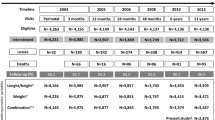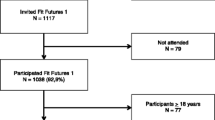Abstract
Summary
The influence of birth weight and length on bone mineral parameters in adolescence is unclear. We found a positive association between birth size and bone mineral content, attenuated by lifestyle factors. This highlights the impact of environmental stimuli and lifestyle during growth.
Purpose
The influence of birth weight and length on bone mineral density and content later in life is unclear, especially in adolescence. This study evaluated the impact of birth weight and length on bone mineral density and content among adolescents.
Methods
We included 961 participants from the population-based Fit Futures study (2010–2011). Dual-energy X-ray absorptiometry (DXA) was used to measure bone mineral density (BMD) and bone mineral content (BMC) at femoral neck (FN), total hip (TH) and total body (TB). BMD and BMC measures were linked with birth weight and length ascertained from the Medical Birth Registry of Norway. Linear regression models were used to investigate the influence of birth parameters on BMD and BMC.
Results
Birth weight was positively associated with BMD-TB and BMC at all sites among girls; standardized β coefficients [95% CI] were 0.11 [0.01, 0.20] for BMD-TB and 0.15 [0.06, 0.24], 0.18 [0.09, 0.28] and 0.29 [0.20, 0.38] for BMC-FN, TH and TB, respectively. In boys, birth weight was positively associated with BMC at all sites with estimates of 0.10 [0.01, 0.19], 0.12 [0.03, 0.21] and 0.15 [0.07, 0.24] for FN, TH and TB, respectively. Corresponding analyses using birth length as exposure gave significantly positive associations with BMC at all sites in both sexes. The significant positive association between birth weight and BMC-TB in girls, and birth length and BMC-TB in boys remained after multivariable adjustment.
Conclusions
We found a positive association between birth size and BMC in adolescence. However, this association was attenuated after adjustment for weight, height and physical activity during adolescence.


Similar content being viewed by others
Change history
10 July 2017
An erratum to this article has been published.
References
Borgstrom F, Kanis JA (2008) Health economics of osteoporosis. Best Pract Res Clin Endocrinol Metab 22(5):885–900
Kanis JA (1993) The incidence of hip fracture in Europe. Osteoporos Int 3(Suppl 1):10–15
Cooper C, Westlake S, Harvey N et al (2009) Developmental origins of osteoporotic fracture. Adv Exp Med Biol 639:217–236
Rizzoli R, Bianchi ML, Garabedian M et al (2010) Maximizing bone mineral mass gain during growth for the prevention of fractures in the adolescents and the elderly. Bone 46(2):294–305
Eisman JA (1999) Genetics of osteoporosis. Endocr Rev 20(6):788–804
Jouanny P, Guillemin F, Kuntz C et al (1995) Environmental and genetic factors affecting bone mass. Similarity of bone density among members of healthy families. Arthritis Rheum 38(1):61–67
Heaney RP, Abrams S, Dawson-Hughes B et al (2000) Peak bone mass. Osteoporos Int 11(12):985–1009
Ferrari S, Rizzoli R, Slosman D et al (1998) Familial resemblance for bone mineral mass is expressed before puberty. J Clin Endocrinol Metab 83(2):358–361
Barker DJ (1995) The fetal and infant origins of disease. Eur J Clin Investig 25(7):457–463
Kuh D, Ben-Shlomo Y, Lynch J et al (2003) Life course epidemiology. J Epidemiol Community Health 57(10):778–783
Steer CD, Tobias JH (2011) Insights into the programming of bone development from the Avon Longitudinal Study of Parents and Children (ALSPAC). Am J Clin Nutr 94(6 Suppl):1861S–1864S
Victora CG, Adair L, Fall C et al (2008) Maternal and child undernutrition: consequences for adult health and human capital. Lancet 371(9609):340–357
Romano T, Wark JD, Owens JA et al (2009) Prenatal growth restriction and postnatal growth restriction followed by accelerated growth independently program reduced bone growth and strength. Bone 45(1):132–141
Jones G, Dwyer T (2000) Birth weight, birth length, and bone density in prepubertal children: evidence for an association that may be mediated by genetic factors. Calcif Tissue Int 67(4):304–308
Ay L, Jaddoe VW, Hofman A et al (2011) Foetal and postnatal growth and bone mass at 6 months: the Generation R Study. Clin Endocrinol 74(2):181–190
Dennison EM, Syddall HE, Sayer AA et al (2005) Birth weight and weight at 1 year are independent determinants of bone mass in the seventh decade: the Hertfordshire cohort study. Pediatr Res 57(4):582–586
Yarbrough DE, Barrett-Connor E, Morton DJ (2000) Birth weight as a predictor of adult bone mass in postmenopausal women: the Rancho Bernardo Study. Osteoporos Int 11(7):626–630
Leunissen RW, Stijnen T, Boot AM et al (2008) Influence of birth size and body composition on bone mineral density in early adulthood: the PROGRAM study. Clin Endocrinol 69(3):386–392
Martìnez-Mesa J, Restrepo-Mendez MC, Gonzalez DA et al (2013) Life-course evidence of birth weight effects on bone mass: systematic review and meta-analysis. Osteoporos Int 24(1):7–18
Jones IE, Williams SM, Goulding A (2004) Associations of birth weight and length, childhood size, and smoking with bone fractures during growth: evidence from a birth cohort study. Am J Epidemiol 159(4):343–350
Winther A, Dennison E, Ahmed LA et al (2014) The Tromso Study: Fit Futures: a study of Norwegian adolescents’ lifestyle and bone health. Arch Osteoporos 9:185
Christoffersen T, Winther A, Nilsen OA et al (2015) Does the frequency and intensity of physical activity in adolescence have an impact on bone? The Tromso Study, Fit Futures. BMC Sports Sci Med Rehabil 7:26
Norwegian Institute of Public Health (2016) Medical Birth Registry of Norway. [cited 2016 9 Dec]; Available from: https://www.fhi.no/en/hn/health-registries/medical-birth-registry-of-norway/
Omsland TK, Emaus N, Gjesdal CG et al (2008) In vivo and in vitro comparison of densitometers in the NOREPOS study. J Clin Densitom 11(2):276–282
Booth ML, Okely AD, Chey T et al (2001) The reliability and validity of the physical activity questions in the WHO health behaviour in schoolchildren (HBSC) survey: a population study. Br J Sports Med 35(4):263–267
Petersen AC, Crockett L, Richards M et al (1988) A self-report measure of pubertal status: reliability, validity, and initial norms. J Youth Adolesc 17(2):117–133
Lucas A, Fewtrell MS, Cole TJ (1999) Fetal origins of adult disease—the hypothesis revisited. BMJ 319(7204):245–249
Jensen RB, Vielwerth S, Frystyk J et al (2008) Fetal growth velocity, size in early life and adolescence, and prediction of bone mass: association to the GH-IGF axis. J Bone Miner Res 23(3):439–446
Prentice A, Parsons TJ, Cole TJ (1994) Uncritical use of bone mineral density in absorptiometry may lead to size-related artifacts in the identification of bone mineral determinants. Am J Clin Nutr 60(6):837–842
Saito T, Nakamura K, Okuda Y et al (2005) Weight gain in childhood and bone mass in female college students. J Bone Miner Metab 23(1):69–75
Teegarden D, Proulx WR, Martin BR et al (1995) Peak bone mass in young women. J Bone Miner Res 10(5):711–715
Eide MG, Oyen N, Skjaerven R et al (2005) Size at birth and gestational age as predictors of adult height and weight. Epidemiology 16(2):175–181
Preece MA, Pan H, Ratcliffe SG (1992) Auxological aspects of male and female puberty. Acta Paediatr Suppl 383:11–13 discussion 14
Cooper C, Harvey N, Cole Z et al (2009) Developmental origins of osteoporosis: the role of maternal nutrition. Adv Exp Med Biol 646:31–39
Dennison EM, Arden NK, Keen RW et al (2001) Birthweight, vitamin D receptor genotype and the programming of osteoporosis. Paediatr Perinat Epidemiol 15(3):211–219
Fall C, Hindmarsh P, Dennison E et al (1998) Programming of growth hormone secretion and bone mineral density in elderly men: a hypothesis. J Clin Endocrinol Metab 83(1):135–139
Godfrey K, Walker-Bone K, Robinson S et al (2001) Neonatal bone mass: influence of parental birthweight, maternal smoking, body composition, and activity during pregnancy. J Bone Miner Res 16(9):1694–1703
Cooper C, Eriksson JG, Forsen T et al (2001) Maternal height, childhood growth and risk of hip fracture in later life: a longitudinal study. Osteoporos Int 12(8):623–629
World Health Organization (2004) Low birthweight—country, regional and global estimates. [cited 2016 9 Dec]; Available from: http://apps.who.int/iris/bitstream/10665/43184/1/9280638327.pdf
Gluckman PD, Hanson MA (2004) Living with the past: evolution, development, and patterns of disease. Science 305(5691):1733–1736
Tuvemo T, Cnattingius S, Jonsson B (1999) Prediction of male adult stature using anthropometric data at birth: a nationwide population-based study. Pediatr Res 46(5):491–495
Acknowledgements
We are grateful to the study participants, the staff at the Clinical Research Unit at the University Hospital of North Norway (UNN HF) and the Fit Futures administration for conducting the study. We thank Robert Kechter at Finnmark Hospital Trust, Carsten Rolland at the School of Sport Sciences, UiT The Arctic University of Norway, and the Garvan Institute of Medical Research for office and administration contributions. We also thank the Norwegian Osteoporosis Association for supporting paediatric software and the Northern Norway Regional Health Authorities for funding this work.
Author information
Authors and Affiliations
Contributions
Study design: TC, AW, LAA and NE. Study conduct: A-SF, GG and NE. Data collection: TC, A-SF, GG, NE, O-AN and AW. Data analysis: TC, LAA and NE. Data interpretation: TC, LAA, EMD and NE. Drafting the manuscript: TC, LAA and NE. Revising the manuscript content: TC, LAA, AKD, EMD, EKE, A-SF, LG-M, GG, O-AN, BS, GST, DV, AW and NE. Approving the final version of the manuscript TC, LAA, AKD, EMD, EKE, A-SF, LG-M, GG, O-AN, BS, GST, DV, AW and NE. TC, LAA and NE take responsibility for the integrity of the data analysis.
Corresponding author
Ethics declarations
The study was approved by The Norwegian Data Protection Authority (reference number 2009/1282) and by The Regional Committee of Medical and Health Research Ethics (reference number 2011/1702/REKnord).
Funding sources
The Northern Norway Regional Health Authorities (SFP1160-14) funded this study. The funders had no role in the study design, data collection, analysis, interpretation or decision to submit this manuscript for publication.
Conflicts of interest
None.
Additional information
This article has been modified to reflect the correct spelling of the name of the co-author Dimitris Vlachopoulos.
An erratum to this article is available at https://doi.org/10.1007/s11657-017-0358-8.
Electronic supplementary material
Supplementary Table 1
(DOCX 13 kb)
Rights and permissions
About this article
Cite this article
Christoffersen, T., Ahmed, L.A., Daltveit, A.K. et al. The influence of birth weight and length on bone mineral density and content in adolescence: The Tromsø Study, Fit Futures. Arch Osteoporos 12, 54 (2017). https://doi.org/10.1007/s11657-017-0348-x
Received:
Accepted:
Published:
DOI: https://doi.org/10.1007/s11657-017-0348-x




